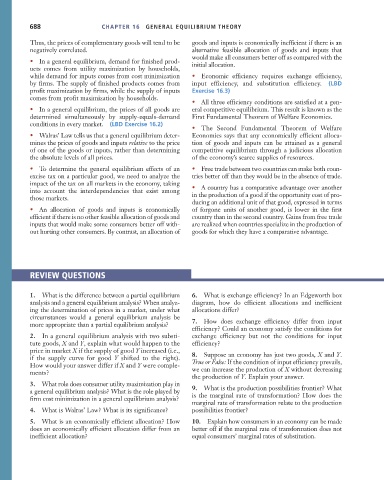Page 714 - Microeconomics, Fourth Edition
P. 714
c16GeneralEquilibriumTheory.qxd 8/16/10 9:14 PM Page 688
688 CHAPTER 16 GENERAL EQUILIBRIUM THEORY
Thus, the prices of complementary goods will tend to be goods and inputs is economically inefficient if there is an
negatively correlated. alternative feasible allocation of goods and inputs that
would make all consumers better off as compared with the
• In a general equilibrium, demand for finished prod- initial allocation.
ucts comes from utility maximization by households,
while demand for inputs comes from cost minimization • Economic efficiency requires exchange efficiency,
by firms. The supply of finished products comes from input efficiency, and substitution efficiency. (LBD
profit maximization by firms, while the supply of inputs Exercise 16.3)
comes from profit maximization by households.
• All three efficiency conditions are satisfied at a gen-
• In a general equilibrium, the prices of all goods are eral competitive equilibrium. This result is known as the
determined simultaneously by supply-equals-demand First Fundamental Theorem of Welfare Economics.
conditions in every market. (LBD Exercise 16.2)
• The Second Fundamental Theorem of Welfare
• Walras’ Law tells us that a general equilibrium deter- Economics says that any economically efficient alloca-
mines the prices of goods and inputs relative to the price tion of goods and inputs can be attained as a general
of one of the goods or inputs, rather than determining competitive equilibrium through a judicious allocation
the absolute levels of all prices. of the economy’s scarce supplies of resources.
• To determine the general equilibrium effects of an • Free trade between two countries can make both coun-
excise tax on a particular good, we need to analyze the tries better off than they would be in the absence of trade.
impact of the tax on all markets in the economy, taking
into account the interdependencies that exist among • A country has a comparative advantage over another
those markets. in the production of a good if the opportunity cost of pro-
ducing an additional unit of that good, expressed in terms
• An allocation of goods and inputs is economically of forgone units of another good, is lower in the first
efficient if there is no other feasible allocation of goods and country than in the second country. Gains from free trade
inputs that would make some consumers better off with- are realized when countries specialize in the production of
out hurting other consumers. By contrast, an allocation of goods for which they have a comparative advantage.
REVIEW QUESTIONS
1. What is the difference between a partial equilibrium 6. What is exchange efficiency? In an Edgeworth box
analysis and a general equilibrium analysis? When analyz- diagram, how do efficient allocations and inefficient
ing the determination of prices in a market, under what allocations differ?
circumstances would a general equilibrium analysis be
more appropriate than a partial equilibrium analysis? 7. How does exchange efficiency differ from input
efficiency? Could an economy satisfy the conditions for
2. In a general equilibrium analysis with two substi- exchange efficiency but not the conditions for input
tute goods, X and Y, explain what would happen to the efficiency?
price in market X if the supply of good Y increased (i.e.,
if the supply curve for good Y shifted to the right). 8. Suppose an economy has just two goods, X and Y.
How would your answer differ if X and Y were comple- True or False: If the condition of input efficiency prevails,
ments? we can increase the production of X without decreasing
the production of Y. Explain your answer.
3. What role does consumer utility maximization play in
a general equilibrium analysis? What is the role played by 9. What is the production possibilities frontier? What
firm cost minimization in a general equilibrium analysis? is the marginal rate of transformation? How does the
marginal rate of transformation relate to the production
4. What is Walras’ Law? What is its significance? possibilities frontier?
5. What is an economically efficient allocation? How 10. Explain how consumers in an economy can be made
does an economically efficient allocation differ from an better off if the marginal rate of transformation does not
inefficient allocation? equal consumers’ marginal rates of substitution.

